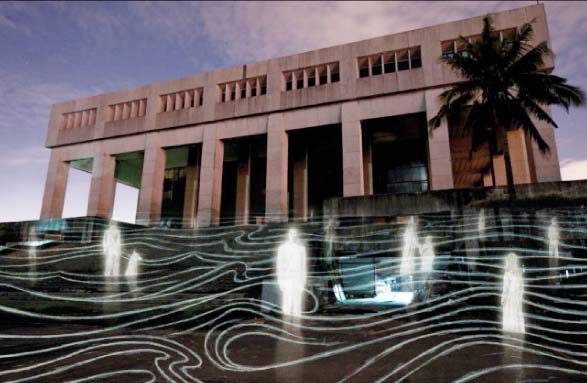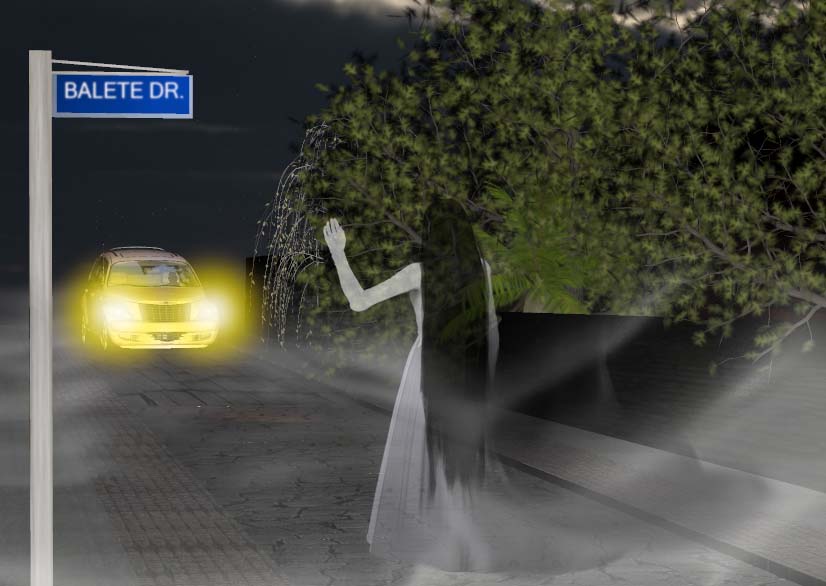Mention the Philippines and most people think of weird food (fertilized duck egg, anyone?) and beautiful beaches. But stick around long enough, and you’ll find that (sometimes literally) beneath the country’s modern malls runs a deeper mythological tradition so rich, it has migrated from the forest to the cities, morphing from myths to urban legends, oftentimes feeding on the public’s fear and reflecting the troubles of that time. They’re dark, they’re strange, and for some reason, they often make it as legitimate stories in the 6 p.m. news. In the early 1980s, especially, people could get jailed for their political views and news shows were forced to run news oddities that a largely Catholic public with heavy animistic leanings took as truth.
Here are some of them:

The ghosts of the Manila Film Center
In 1981, when the Philippines was still under martial law imposed by dictator Ferdinand Marcos, his wife Imelda decided that Manila should have its own international film festival. She envisioned a festival to rival all festivals, complete with compelling films and Hollywood stars.
At the center of the film fest would be the Manila Film Center, an edifice dedicated to celluloid. Construction was rushed to make sure that the building was finished in time for the festival. A thousand workers completed the lobby in 72 hours, instead of the weeks it normally required.
On Nov. 17, 1981, a scaffolding collapsed, leaving 169 workers trapped in quick-dry cement for over nine hours. Because of the media clampdown during martial law, a rumor quickly spread that the dead and injured workers weren’t rescued, and instead were left in the cement, their protruding limbs hacked off and covered with more cement to make sure that construction went according to schedule.
Today, the Film Center is considered one of the most haunted buildings in Manila. People claim that the restless spirits wander around the building where their bodies were buried, angry that they weren’t given a proper burial.
Many people, from ghost hunters to news teams, have explored the building, and depending on who you talk to, they have either found evidence of supernatural activity, or none at all. Nevertheless, the Film Center is used by a Korean company that does burlesque drag shows, as no Filipino will dare go near it.

The white lady of Balete Drive
Balete Drive is a main road in New Manila, an upper class neighborhood in Quezon City. The dimly lit thoroughfare is named after the balete tree, known elsewhere as banyan tree or strangler figs, huge, imposing trees that start off as a vine winding its way around a host tree, then strangling it as it takes over.
In Philippine folklore, balete trees are home to elementals, and can be gateways into the otherworld.
Balete Drive’s story, however, is far more recent.
In the 1980s, word spread that the area was haunted by a lady in white who, in the middle of the night, hails a cab, gets inside, then disappears mid-journey.
Other versions have her hailing a cab and getting down outside an old house, telling the driver to wait while she gets cash. The driver waits for a long time, until finally, he gets impatient and rings the doorbell. When he tells the old lady who opens the door about his passenger’s promise of payment, she pales and tells him that the person he described is her daughter, who just died.
People believe that the white lady was a woman who was raped and killed by a cab driver on that street, hence, her choice of victims. So far, there have been no reports of a murder of that sort taking place, and in the early 2000s, a tabloid news reporter admitted that he made up the story on a slow news day. Still, the story persists, and remains one of Manila’s most popular urban legends.
The snake man of Robinsons mall
In the early 1990s, actress Alice Dixon went on national news saying that she was attacked by a half-man, half-snake while in the dressing room of Robinsons Mall. The floor supposedly opened up, depositing her into a room where the snake-man waited, ready to devour its victim.
Dixon managed to escape, depending on which version you read, either by hanging onto the edge of the trap door and hauling herself up or by making the creature fall in love with her. The actress claimed that the snake man was the son of the mall owner, the deformed twin brother of his eldest daughter.
The urban legend faded into obscurity, but not before the mall chain suffered a huge loss. We weren’t allowed to shop in those malls for years, just in case the trap doors in the dressing rooms were real. The story resurfaced last 2009, when someone claimed to have taken a photo of the snake-man and put it on the Internet. The very suspicious-looking photo was still making the rounds of the web as late as 2012.
The spirit in the UP jeepney
The University of the Philippines is said to be haunted, with each building harboring its own ghost. They say that the College of Mass Communication contains a gateway to hell, and that the College of Education is home to a spirit at least as big as the building itself. The university’s tree-lined roads are believed to be similarly haunted, especially since not all of them are properly illuminated at night.
An urban legend making the rounds of the University of the Philippines is about a student who hailed a jeepney on campus late at night. She noticed that she was the only passenger, and that driver had looked at her strangely when she got on. This scared her, as it was late, the roads tended to be dark, the campus was practically deserted, and there were rumors of women getting raped if they weren’t careful.
As the jeep made its way, she noticed that it wasn’t following its usual route, that the driver was taking her on a long, circuitous path around the campus. Her fear mounted as she noticed the driver looking at her through the rear-view mirror, a worried look on his face. Finally, he stopped somewhere near her dorm.
As she shakily got down, he turned towards her and said, “Take off your clothes and burn them as soon as you get to your dorm.” When the student asked why, the driver said, “When you got on my jeep, you didn’t have a head. I had to take the long route to make sure that we lost the spirit that wanted to claim you.”
Technology and urban legends
Technology hasn’t stopped people from believing in spirits, elementals, and monsters. In fact, it may have aided the rise in their belief, especially in the provinces.
In 2009, Dumaguete City, a sleepy university town in the province of Negros Oriental, was the scene of a mob gathered outside the local weather station demanding that the weather authorities release the mermaid that they supposedly had in their possession.
The province, normally untouched by the typhoons that ravage the country annually, had just suffered from a particularly bad storm, and the locals believed this was because authorities had angered the sea gods by capturing a water elemental.
The news item never explained how the authorities managed to calm the mob, or if they really had a captive mermaid that they eventually released into the wild.
Friendlier news reports talk about people dropping by the weather station hoping to catch a glimpse of the mermaid. They would awkwardly ask about other things before getting to the real reason behind their visit.
I saw how technology aided the spread of an urban legend myself while vacationing on the island of Romblon. I overheard one of my friend’s employees tell his mother that he received a mass text message about a family of aswangs (viscera suckers introduced to American pop culture via the television show “Grimm”) who had escaped police custody on another island and were making their way to the island we were on right that minute. His mother said that she and some of the other employees had gotten the same text message, and they proceeded to talk about the precautions they should take should the text turn out to be true (hang garlic from the windows, have rock salt handy to throw at the monster), before eventually deciding that it was probably a hoax and they should get on with work.
I did notice that they left a little earlier that night, though.
(First appeared in MYS Universe blog, Feb. 11, 2016.)
